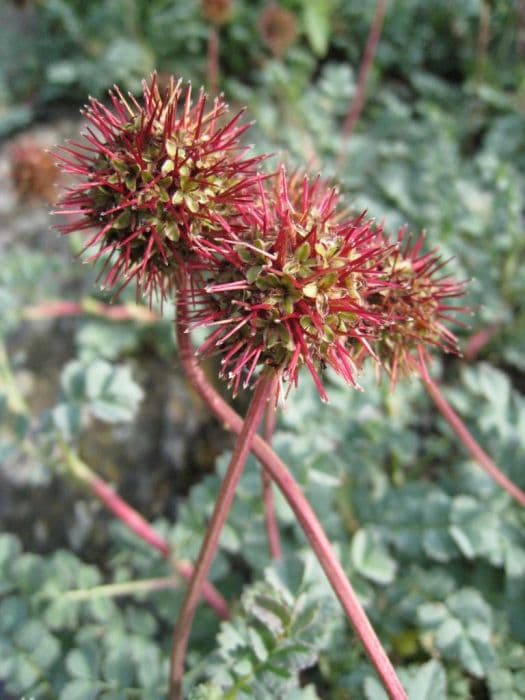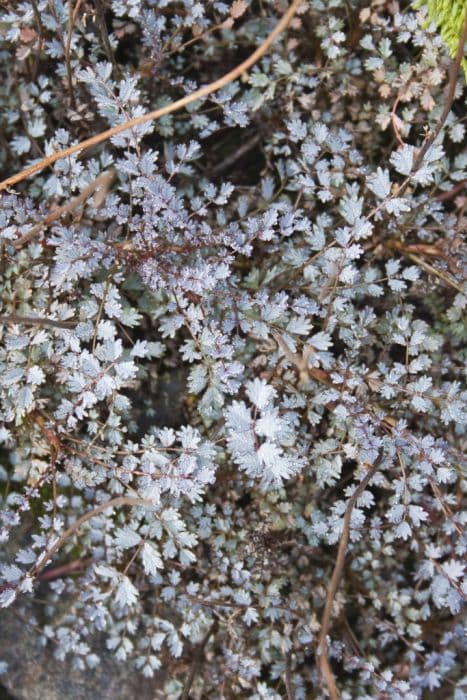Japanese Apricot Prunus mume 'Omoi-no-mama' (d)

ABOUT
The Prunus mume 'Omoi-no-mama', commonly known as the flowering apricot, presents a captivating display with its remarkable floral characteristics. This plant is admired for its blossoms which appear before the foliage in late winter to early spring, signaling the end of dreary cold months. The flowers exude an irresistible fragrance that can permeate the surroundings, adding an aromatic delight to the garden. These blossoms are typically pink, but depending on the particular plant, the shades can vary, sometimes showing a blend of pink hues or a gradient from white to deep pink. Each flower is composed of five rounded petals, forming a harmonious, cup-shaped bloom that invites admiration and serves as an early source of nectar for pollinators. Beyond its enchanting flowers, the foliage of the flowering apricot is also rather attractive, emerging in a vibrant green hue that later transitions into a more subdued color as the seasons progress. The leaves are oval with pointed tips and possess a slightly serrated edge, which adds texture to its overall appearance. During autumn, the foliage might turn into a different palette of colors, providing visual interest throughout various seasons. In addition to its floral display, the plant may also produce fruit, which are small and resemble miniature versions of the typical apricot. These fruits are usually not the main attraction and are often overshadowed by the spectacular show of the plant's blooms. Overall, the Prunus mume 'Omoi-no-mama' is adorned with delightful flowers and pleasant foliage which together create an ornamental profile that is cherished by many garden enthusiasts.
About this plant
 Names
NamesSynonyms
Japanese Apricot, Ume, Chinese Plum, Mume.
Common names
Prunus mume 'Omoi-no-mama'
 Toxicity
ToxicityTo humans
Prunus mume, commonly known as the Japanese apricot, contains cyanogenic glycosides, primarily amygdalin, in its seeds. If ingested in large enough quantities, these compounds can release cyanide in the body, which is toxic to humans. Symptoms of cyanide poisoning from consuming the seeds can include headache, dizziness, confusion, difficulty breathing, and can potentially lead to respiratory failure and death if not treated promptly.
To pets
Japanese apricot can also be toxic to pets due to the amygdalin present in the seeds. If pets consume the seeds, they could experience symptoms similar to humans, such as vomiting, difficulty breathing, and potentially lead to more severe consequences such as cyanide poisoning, which can be fatal without immediate veterinary intervention.
 Characteristics
CharacteristicsLife cycle
Perennials
Foliage type
Deciduous
Color of leaves
Green
Flower color
Pink
Height
15-20 feet (4.5-6 meters)
Spread
15-20 feet (4.5-6 meters)
Plant type
Tree
Hardiness zones
6
Native area
Asia
Benefits
 General Benefits
General Benefits- Aesthetic appeal: The Prunus mume 'Omoi-no-mama' offers beautiful pink to white blossoms that are highly valued for their visual impact in gardens and landscapes.
- Fragrance: The flowers emit a pleasant aroma that can enhance the sensory experience of a garden.
- Cultural significance: Commonly known as the Japanese apricot or Ume, this plant has deep cultural and historical importance in Japan, often celebrated in festivals and art.
- Wildlife attraction: The blossoms provide nectar for pollinators such as bees, while the fruit can attract birds and other wildlife.
- Seasonal interest: Ume trees have a distinctive flowering pattern, often blooming in late winter to early spring, adding interest to gardens during a time when few other plants are in flower.
- Culinary uses: Although not a general benefit of the ornamental cultivar, the species produces Ume fruits which can be used in various culinary preparations like pickling and making umeboshi.
- Shade and shelter: Once mature, the tree can provide shade and shelter in a garden setting.
 Medical Properties
Medical PropertiesThis plant is not used for medical purposes.
 Air-purifying Qualities
Air-purifying QualitiesThis plant is not specifically known for air purifying qualities.
 Other Uses
Other Uses- Japanese apricot wood is sometimes used in the crafting of traditional Japanese furniture, owing to its strength and beautiful grain.
- The blossoms of the Japanese apricot are a popular motif in Japanese art and design, symbolizing early spring and perseverance.
- Japanese apricot can be used as a natural dye, providing a range of colors from pale yellows to rich greens depending on the mordant used.
- Dried Japanese apricot flowers can be incorporated into sachets and potpourris, contributing a mild and pleasant fragrance.
- The petals of the Japanese apricot are sometimes candied or preserved in sugar for decorative use on desserts.
- Its dense canopy can provide shade and a cool microclimate in gardens, courtyards, or small urban spaces.
- Japanese apricots are often used in bonsai, the art of creating miniature trees, because of their attractive bark and flowering habits.
- The tree's blossom is a symbol of resilience and renewal, often used in New Year celebrations and traditional ceremonies.
- Practices like 'ume-shigoto' involve crafting various crafts and ornaments from Japanese apricot blossoms and branches to celebrate the plum festival called 'Ume Matsuri.'
- The fragrance of the blossoms is sometimes captured and used in perfumery and aromatherapy, offering a subtle and distinctive scent.
Interesting Facts
 Feng Shui
Feng ShuiThe Japanese apricot is not used in Feng Shui practice.
 Zodiac Sign Compitability
Zodiac Sign CompitabilityThe Japanese apricot is not used in astrology practice.
 Plant Symbolism
Plant Symbolism- Endurance and Hope: As a variety of flowering apricot, Prunus mume 'Omoi-no-mama' often blooms in late winter, when most other plants remain dormant. This characteristic symbolizes both endurance through hardship and the hope of spring's imminent arrival.
- Grace and Elegance: The delicate and fragrant blossoms of the flowering apricot represent refinement and sophistication. Its graceful branches and the light pink to white flowers are associated with beauty and gentility.
- Renewal and Fresh Beginnings: The flowering apricot's early bloom is a herald of the new year in East Asian cultures, symbolizing fresh starts and the shedding of old patterns.
- Perseverance: In the face of cold and adverse winter conditions, the flowering apricot perseveres to bloom, symbolizing steadfastness and the ability to triumph over challenges.
- Overcoming Adversity: The ability of the flowering apricot to bloom vibrantly amidst the harshness of winter is seen as emblematic of overcoming adversity and emerging stronger for it.
 Water
WaterThe Japanese Apricot, or Prunus mume, should be watered deeply to encourage deep root growth, which typically means once a week during the growing season if there is no significant rainfall. The amount of water should be roughly 1-2 gallons per watering for young trees, adjusting for mature trees based on their size and the soil's moisture level. During the dormant season, watering can be reduced significantly. Ensure that the soil drains well as the plant does not tolerate waterlogged conditions. In times of drought, water the tree every two weeks.
 Light
LightThe Japanese Apricot thrives in full sun, meaning at least six hours of direct, unfiltered sunlight per day. Plant it in a spot where it can enjoy the morning sun which is less harsh than the afternoon sun. Adequate light is crucial for flower and fruit production, so avoid planting it in shaded areas.
 Temperature
TemperatureThe Japanese Apricot is hardy and can tolerate a winter low of around 5°F, while the maximum temperature should not exceed 95°F. The ideal temperature range for this plant is between 60°F and 75°F. It’s important to protect the tree from late spring frosts which can damage blossoms.
 Pruning
PruningPrune the Japanese Apricot to maintain its shape, remove dead or diseased wood, and to encourage fruit production. The best time for pruning is after flowering in late winter or early spring before new growth starts. Thinning the branches helps to increase sun and air circulation, which is beneficial for the tree’s health and fruit set. Pruning should be done annually or as needed to maintain a robust structure.
 Cleaning
CleaningAs needed
 Soil
SoilJapanese Apricot 'Omoi-no-mama' prefers well-drained, fertile soil with a slightly acidic to neutral pH range of 5.5 to 7.0. The best soil mix consists of loamy garden soil, peat moss, and perlite or sand to improve drainage. Adding organic matter like compost enriches the soil and promotes healthy growth.
 Repotting
RepottingJapanese Apricot 'Omoi-no-mama' should be repotted every 2-3 years. Young plants may require more frequent repotting, while mature specimens can be repotted less often. Choose a pot only slightly larger than the previous one to encourage flowering and fruiting.
 Humidity & Misting
Humidity & MistingJapanese Apricot 'Omoi-no-mama' prefers moderate humidity levels and can adapt to typical outdoor conditions. While specific humidity levels are not critical, ensuring the environment is not too dry can promote healthy growth and flowering.
 Suitable locations
Suitable locationsIndoor
Ensure bright light, cool temperatures, and seasonal conditions.
Outdoor
Choose a sunny spot, shield from strong winds, and water regularly.
Hardiness zone
6-9 USDA
 Life cycle
Life cycleThe flowering apricot, specifically the Prunus mume 'Omoi-no-mama', starts its life cycle as a seed, developing within the fruit that forms after the tree's flowering period. Upon germination, the seed grows into a seedling with basic leaf structures, and establishes itself as a sapling with a primary root and increasing foliage. As it matures into a young tree, it undergoes vegetative growth, producing more complex leaf patterns, branches, and a sturdy trunk. The tree reaches reproductive maturity after a few years, meaning it is capable of producing flowers, typically in late winter to early spring, which are pollinated by insects, leading to fruit development. After fruiting, seeds are dispersed, naturally or through human intervention, to give life to new plants. Throughout its life, the flowering apricot goes through cycles of growth, flowering, and dormancy, commonly adapting to seasonal changes.
 Propogation
PropogationPropogation time
Spring-Early Summer
Prunus mume 'Omoi-no-mama', commonly known as the Japanese flowering apricot, is best propagated through grafting, particularly during the dormant season, which usually spans from late winter to early spring. Grafting involves joining a piece of stem from the 'Omoi-no-mama' with a rootstock of another Prunus species that is compatible and hardy. A commonly used method is 'bud grafting,' where a single bud from the Japanese flowering apricot is inserted under the bark of the rootstock. After making a T-shaped cut on the rootstock's bark, the bud, along with a small piece of the bark, is slipped into the flap, which is then wrapped with grafting tape to hold it in place and protect it until the bud fuses with the rootstock and begins to grow. This method is favored for its efficiency and the speed at which the grafted plants become established and ready for transplanting into the garden.









